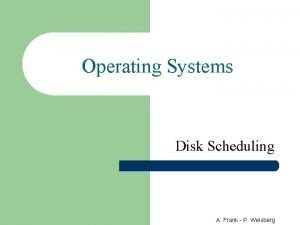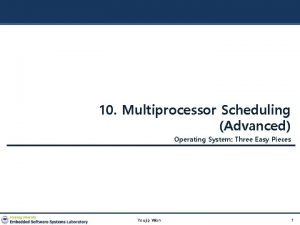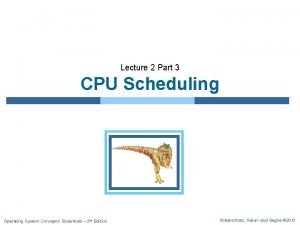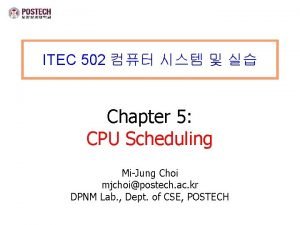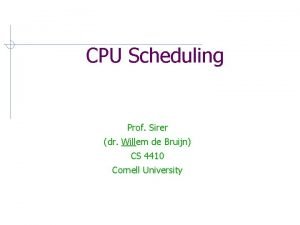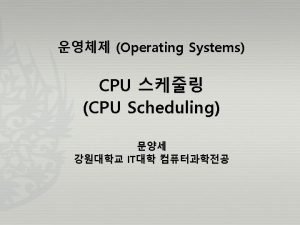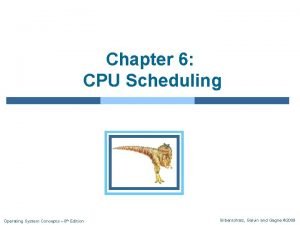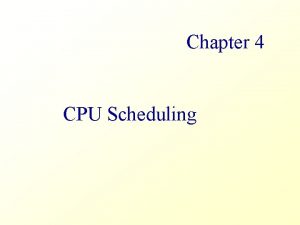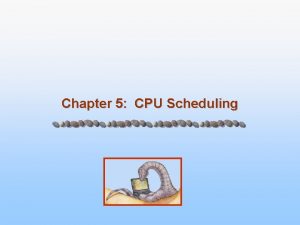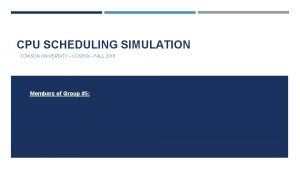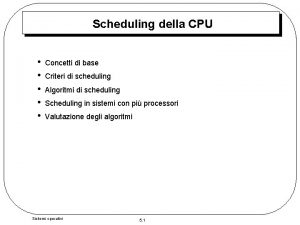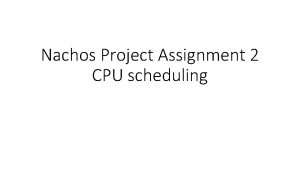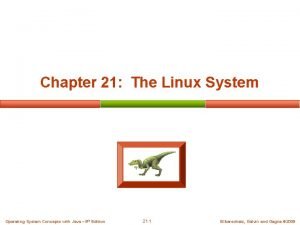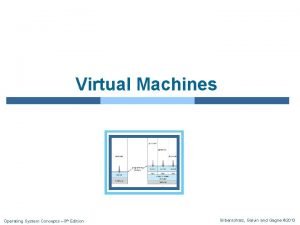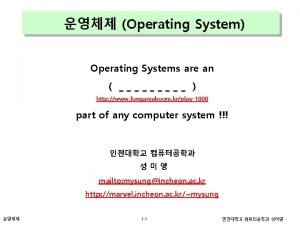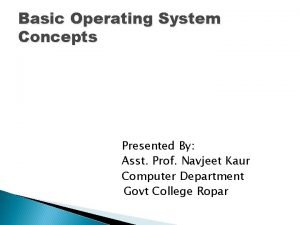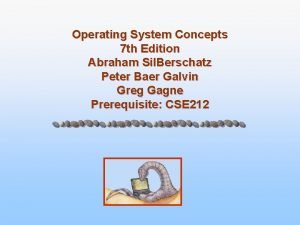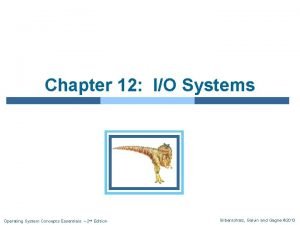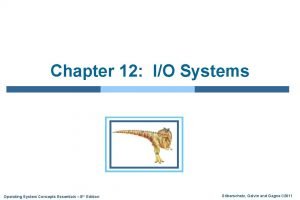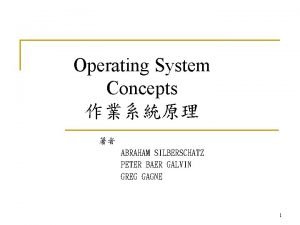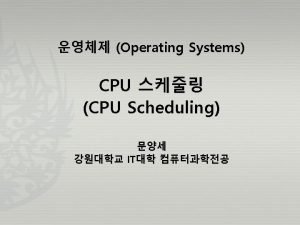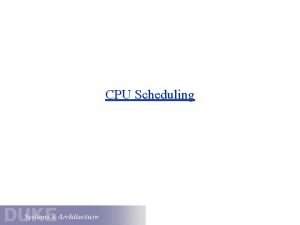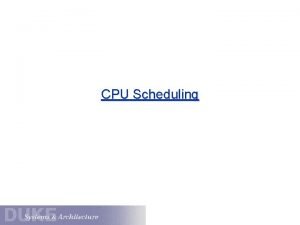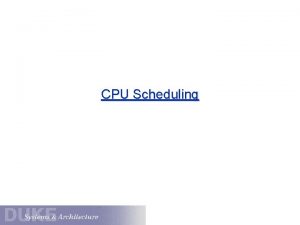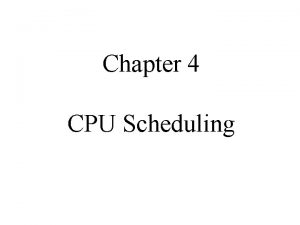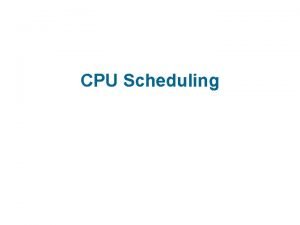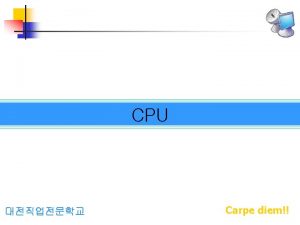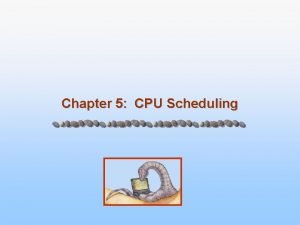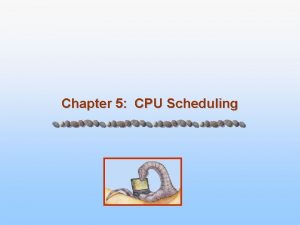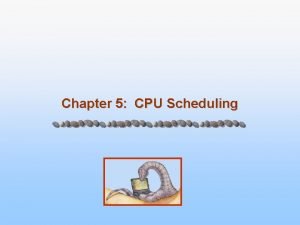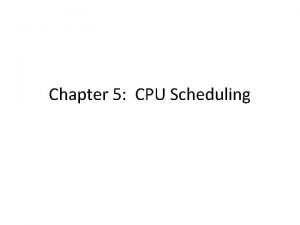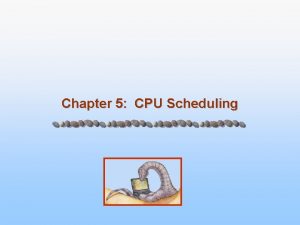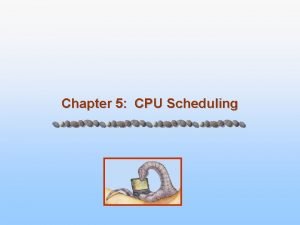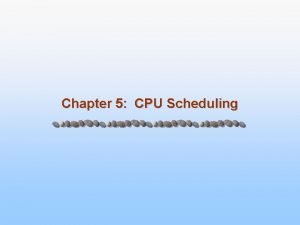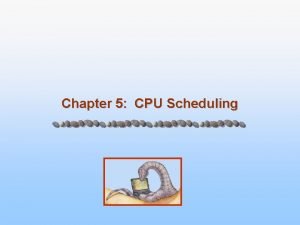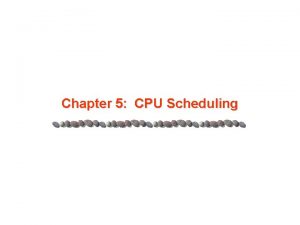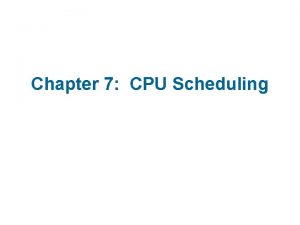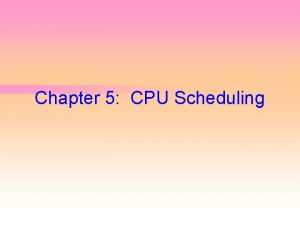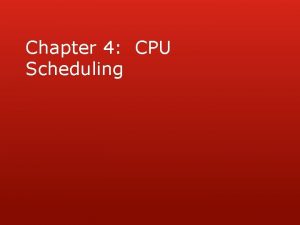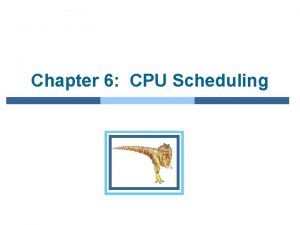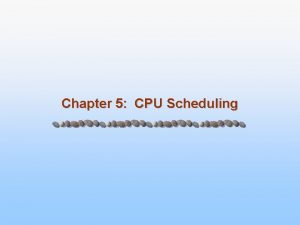Operating System Concepts Chapter 6 CPU Scheduling Lecturer





































- Slides: 37

Operating System Concepts Chapter #6 CPU Scheduling Lecturer Dr. Bassam Alqaralleh Operating System Concepts

Chapter 6: CPU Scheduling • • • Basic Concepts Scheduling Criteria Scheduling Algorithms Multiple-Processor Scheduling Real-Time Scheduling Algorithm Evaluation Operating System Concepts

Basic Concepts • Maximum CPU utilization obtained with multiprogramming • CPU–I/O Burst Cycle – Process execution consists of a cycle of CPU execution and I/O wait. • CPU burst While scheduling, each process gets to use the CPU for it's slice. The slice that it gets, is called the CPU burst. In simple terms, the duration for which a process gets control of the CPU is Operating System Concepts

Alternating Sequence of CPU And I/O Bursts Operating System Concepts

CPU Scheduler • Selects from among the processes in memory that are ready to execute, and allocates the CPU to one of them. • CPU scheduling decisions may take place when a process: 1. Switches from running to waiting state. 2. Switches from running to ready state. 3. Switches from waiting to ready. 4. Terminates. • Scheduling under 1 and 4 is non-preemptive • All other scheduling is preemptive. Operating System Concepts

Dispatcher • Dispatcher module gives control of the CPU to the process selected by the short-term scheduler; this involves: – switching context – switching to user mode – jumping to the proper location in the user program to restart that program • Dispatch latency – time it takes for the dispatcher to stop one process and start another running. Operating System Concepts

Scheduling Criteria • CPU utilization – keep the CPU as busy as possible • Throughput – # of processes that complete their execution per time unit • Turnaround time – amount of time to execute a particular process • Waiting time – amount of time a process has been waiting in the ready queue • Response time – amount of time it takes from when a request was submitted until the first response is produced, not output (for timesharing environment) Operating System Concepts

Optimization Criteria • • • Max CPU utilization Max throughput Min turnaround time Min waiting time Min response time Operating System Concepts

First-Come, First-Served (FCFS) Scheduling Process Burst Time P 1 24 P 2 3 P 3 3 • Suppose that the processes arrive in the order: P 1 , P 2 , P 3 The Gantt Chart for the schedule is: P 1 0 P 2 24 Operating System Concepts P 3 27 30

FCFS Scheduling (Cont. ) Suppose that the processes arrive in the order P 2 , P 3 , P 1. • The Gantt chart for the schedule is: P 2 • • 0 P 3 3 P 1 6 P 1 = 30 Waiting time for 6; P 2 = 0; P 3 = 3 Average waiting time: (6 + 0 + 3)/3 = 3 Much better than previous case. Convoy effect short process behind long process Operating System Concepts

Shortest-Job-First (SJF) Scheduling • Associate with each process the length of its next CPU burst. Use these lengths to schedule the process with the shortest time. • Two schemes: – nonpreemptive – once CPU given to the process it cannot be preempted until completes its CPU burst. – preemptive – if a new process arrives with CPU burst length less than remaining time of current executing process, preempt. This scheme is known as the Shortest-Remaining-Time-First (SRTF). • SJF is optimal – gives minimum average waiting time for a given set of processes. Operating System Concepts

Example of Non-Preemptive SJF Process Arrival Time Burst Time P 1 0. 0 7 P 2 2. 0 4 P 3 4. 0 1 P 4 5. 0 4 P 1 0 3 P 3 7 P 2 8 P 4 12 • SJF (non-preemptive) Operating System Concepts 16

Example of Preemptive SJF Process. Arrival Time. Burst Time P 1 0. 0 7 P 2 2. 0 4 P 3 4. 0 1 P 4 5. 0 4 P 1 0 P 2 2 P 3 4 P 2 5 P 4 7 P 1 11 Operating System Concepts 16

Determining Length of Next CPU Burst • Can only estimate the length. • Can be done by using the length of previous CPU bursts, using exponential averaging. Operating System Concepts

Prediction of the Length of the Next CPU Burst Operating System Concepts

Examples of Exponential Averaging • =0 – n+1 = n – Recent history does not count. • =1 – n+1 = tn – Only the actual last CPU burst counts. • If we expand the formula, we get: n+1 = tn+(1 - ) tn -1 + … +(1 - )j tn -1 + … +(1 - )n=1 tn 0 • Since both and (1 - ) are less than or equal to 1, each successive term has less weight than its predecessor. Operating System Concepts

Priority Scheduling • A priority number (integer) is associated with each process • The CPU is allocated to the process with the highest priority (smallest integer highest priority). – Preemptive – nonpreemptive • SJF is a priority scheduling where priority is the predicted next CPU burst time. • Problem Starvation – low priority processes may never execute. • Solution Aging – as time progresses increase the priority of the process. Operating System Concepts

Round Robin (RR) • Each process gets a small unit of CPU time (time quantum), usually 10 -100 milliseconds. After this time has elapsed, the process is preempted and added to the end of the ready queue. • If there are n processes in the ready queue and the time quantum is q, then each process gets 1/n of the CPU time in chunks of at most q time units at once. No process waits more than (n-1)q time units. • Performance – q large FIFO – q small q must be large with respect to context switch, otherwise overhead is too high. Operating System Concepts

Example of RR with Time Quantum = 20 Process Burst Time P 1 53 P 2 17 P 3 68 P 4 24 • The Gantt chart is: P 1 0 P 2 20 37 P 3 P 4 57 P 1 77 P 3 P 4 P 1 P 3 97 117 121 134 154 162 Operating System Concepts

Time Quantum and Context Switch Time Operating System Concepts

Turnaround Time Varies With The Time Quantum Operating System Concepts

Multilevel Queue • Ready queue is partitioned into separate queues: foreground (interactive) background (batch) • Each queue has its own scheduling algorithm, foreground – RR background – FCFS • Scheduling must be done between the queues. – Fixed priority scheduling; (i. e. , serve all from foreground then from background). Possibility of starvation. – Time slice – each queue gets a certain amount of CPU time which it can schedule amongst its processes; i. e. , 80% to foreground in RR – 20% to background in FCFS Operating System Concepts

Multilevel Queue Scheduling Operating System Concepts

Multilevel Feedback Queue • A process can move between the various queues; aging can be implemented this way. • Multilevel-feedback-queue scheduler defined by the following parameters: – number of queues – scheduling algorithms for each queue – method used to determine when to upgrade a process – method used to determine when to demote (downgrade) a process – method used to determine which queue a process will enter when that process needs service Operating System Concepts

Example of Multilevel Feedback Queue • Three queues: – Q 0 – time quantum 8 milliseconds – Q 1 – time quantum 16 milliseconds – Q 2 – FCFS • Scheduling – A new job enters queue Q 0 which is served FCFS. When it gains CPU, job receives 8 milliseconds. If it does not finish in 8 milliseconds, job is moved to queue Q 1. – At Q 1 job is again served FCFS and receives 16 additional milliseconds. If it still does not complete, it is preempted and moved to queue Q 2. Operating System Concepts

Multilevel Feedback Queues Operating System Concepts

Multiple-Processor Scheduling • CPU scheduling more complex when multiple CPUs are available. • Homogeneous processors within a multiprocessor. • Load sharing • Asymmetric multiprocessing – only one processor accesses the system data structures, alleviating the need for data sharing. Operating System Concepts

Real-Time Scheduling Divided into two types: • Hard real-time systems – required to complete a critical task within a guaranteed amount of time. • Soft real-time computing – requires that critical processes receive priority over less fortunate ones. Operating System Concepts

Soft real-time systems • Implementing soft real-time functionality requires careful design of the scheduler and related aspects of the operating system. 1 - The system must implement priority scheduling, and real- time processes must have the highest priority. The priority of real-time processes must not degrade over time, even though the priority of non-real-time processes may. 2 - The dispatch latency must be small. The smaller the latency, the faster a real-time process can start executing once it is runable. Operating System Concepts

Soft Real-Time Systems cont. • To keep dispatch latency low, we need to allow system calls to be preemtible. 1 - Insert preemption points in long duration system calls. Preemption point can be placed at only safe locations in the kernel- only where kernel data structures are not being modified. (Few preemption points can be added to the kernel) 2 - Make the entire kernel preemtible. Any kernel data being updated are protected from modification by the high-priority process. Operating System Concepts

Soft Real-Time Systems cont. But what happens if the higher-priority process needs to read or modify kernel data currently being accessed by another. 1 - Priority inversion: high priority process would be waiting for a lower-priority one to finish. 2 - Priority-inheritance protocol: all processes, that are accessing resources that the high-priority process needs, inherits the high-priority until they are done with the resource in question. Operating System Concepts

Dispatch Latency Operating System Concepts

The conflict phase This phase components: of dispatch latency has two 1 - Preemption of any process running in the kernel. 2 - Release by low-priority processes resources needed by the high-priority process Operating System Concepts

Algorithm Evaluation • Deterministic modeling : Takes a particular predetermined workload and defines the performance of each algorithm for that workload. • Simulation: Imitating the scheduling algorithm on a “representative” sample of processes, and computing the resulting performance. (Trace tape: record of the sequence of actual events in the real system which can be used to drive the simulation) • Queuing models • Implementation Operating System Concepts

Evaluation of CPU Schedulers by Simulation Operating System Concepts

Solaris 2 Scheduling Operating System Concepts

Windows 2000 Priorities Operating System Concepts
 Lecturer's name
Lecturer's name Operating system concepts chapter 8 solutions
Operating system concepts chapter 8 solutions Operating system concepts chapter 5 solutions
Operating system concepts chapter 5 solutions Operating system concepts chapter 5 solutions
Operating system concepts chapter 5 solutions Disk structure in os
Disk structure in os Single queue multiprocessor scheduling
Single queue multiprocessor scheduling Sjf cpu scheduling
Sjf cpu scheduling Sjf cpu scheduling
Sjf cpu scheduling Sjf cpu scheduling
Sjf cpu scheduling Gantt chart first come first serve
Gantt chart first come first serve Cpu i/o
Cpu i/o Sjf cpu scheduling
Sjf cpu scheduling Types of cpu scheduling
Types of cpu scheduling A cpu scheduling algorithm determines an order
A cpu scheduling algorithm determines an order Cpu scheduling project
Cpu scheduling project Scheduling della cpu
Scheduling della cpu Cpu scheduling project
Cpu scheduling project Sjn scheduling
Sjn scheduling Operating system
Operating system Linux operating system concepts
Linux operating system concepts Operating system concepts with java
Operating system concepts with java Operating system concepts 6th edition
Operating system concepts 6th edition Operating system concepts 9
Operating system concepts 9 Real time operating system concepts
Real time operating system concepts 교보 drm
교보 drm Basic concepts of os
Basic concepts of os Operating system concepts 11th
Operating system concepts 11th Operating system concepts essentials
Operating system concepts essentials Operating system concepts essentials
Operating system concepts essentials Peter baer galvin
Peter baer galvin Jeannie watkins
Jeannie watkins Spe distinguished lecturer
Spe distinguished lecturer How do you greet your teacher in the afternoon
How do you greet your teacher in the afternoon Photography lecturer
Photography lecturer Lecturer in charge
Lecturer in charge Designation lecturer
Designation lecturer Designation of lecturer
Designation of lecturer Guest lecturer in geography
Guest lecturer in geography




